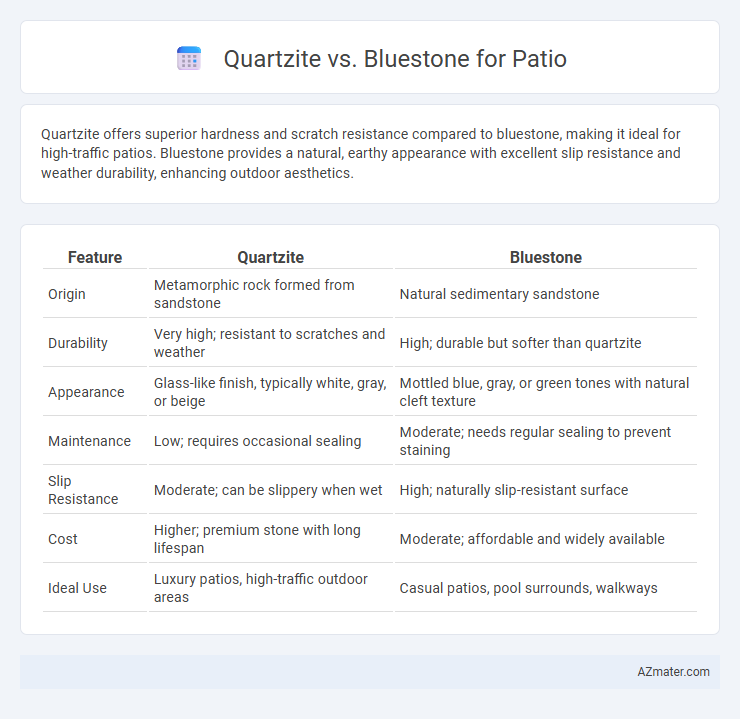Quartzite offers superior hardness and scratch resistance compared to bluestone, making it ideal for high-traffic patios. Bluestone provides a natural, earthy appearance with excellent slip resistance and weather durability, enhancing outdoor aesthetics.
Table of Comparison
| Feature | Quartzite | Bluestone |
|---|---|---|
| Origin | Metamorphic rock formed from sandstone | Natural sedimentary sandstone |
| Durability | Very high; resistant to scratches and weather | High; durable but softer than quartzite |
| Appearance | Glass-like finish, typically white, gray, or beige | Mottled blue, gray, or green tones with natural cleft texture |
| Maintenance | Low; requires occasional sealing | Moderate; needs regular sealing to prevent staining |
| Slip Resistance | Moderate; can be slippery when wet | High; naturally slip-resistant surface |
| Cost | Higher; premium stone with long lifespan | Moderate; affordable and widely available |
| Ideal Use | Luxury patios, high-traffic outdoor areas | Casual patios, pool surrounds, walkways |
Introduction to Quartzite and Bluestone
Quartzite, a natural metamorphic rock formed from sandstone, is prized for its durability and resistance to heat, making it an excellent choice for patios exposed to direct sunlight. Bluestone, a dense sedimentary sandstone, features a unique blue-gray hue and a finely textured surface, offering a blend of aesthetic appeal and slip resistance ideal for outdoor flooring. Both stones provide distinct advantages in strength and visual character, influencing their suitability and maintenance needs for patio installations.
Key Characteristics of Quartzite
Quartzite is an exceptionally durable natural stone renowned for its hardness and resistance to scratches, making it ideal for high-traffic patio areas. Its dense composition offers superior resistance to weathering, ensuring longevity against freeze-thaw cycles and UV exposure. Quartzite's natural variations in color and texture provide a sophisticated, slip-resistant surface that enhances outdoor aesthetics while maintaining practicality.
Key Characteristics of Bluestone
Bluestone is a dense, fine-grained sandstone known for its durability and natural slip resistance, making it ideal for patios that endure heavy foot traffic and various weather conditions. Its rich blue-gray hues and subtle variations add a timeless, elegant aesthetic that complements both traditional and modern outdoor designs. Bluestone also boasts low porosity, which enhances its resistance to staining and freeze-thaw damage, ensuring long-lasting performance in diverse climates.
Appearance and Color Variations
Quartzite offers a dazzling, glassy finish with colors ranging from whites and greys to vibrant blues and greens, providing a natural sparkle that enhances patio aesthetics. Bluestone displays a more subdued, matte texture with earthy tones like slate blue, gray, and brown, lending a classic and rustic charm to outdoor spaces. Both stones exhibit unique color variations that influence patio style, with quartzite presenting more striking patterns while bluestone supports a uniform, consistent look.
Durability and Strength Comparison
Quartzite offers exceptional durability and high resistance to scratching and weathering, making it an ideal choice for patios exposed to heavy foot traffic and harsh environmental conditions. Bluestone, while durable and naturally slip-resistant, is generally softer and more prone to chipping or erosion over time compared to quartzite. The superior strength and hardness of quartzite ensure longer-lasting structural integrity and minimal maintenance in outdoor patio applications.
Slip Resistance and Safety
Quartzite offers superior slip resistance for patios due to its natural textured surface and hardness, making it a safer choice in wet or icy conditions. Bluestone, while aesthetically pleasing with its smooth finish, can become slippery when wet, requiring additional treatments or sealants to enhance safety. Evaluating slip resistance ratings and maintenance needs helps ensure both materials meet safety standards for outdoor patio use.
Maintenance and Longevity
Quartzite offers superior durability and low maintenance for patios, resisting scratches, stains, and weathering better than bluestone. Bluestone requires more frequent sealing and cleaning to prevent damage from moisture and staining, which can affect its long-term appearance. Over time, quartzite's natural hardness ensures longer-lasting patios with minimal upkeep compared to the softer, more porous bluestone.
Installation Process and Challenges
Quartzite patios require professional installation due to their hardness and weight, demanding specialized cutting tools and precise handling to avoid cracking. Bluestone, being softer and more porous, allows for easier cutting and shaping but poses challenges with moisture absorption and potential staining during installation. Both materials necessitate proper groundwork and sealing to ensure durability and prevent shifting or weather-related damage.
Cost and Value Considerations
Quartzite typically costs between $15 and $30 per square foot, offering exceptional durability and a natural, high-end appearance that enhances patio value over time. Bluestone, with prices ranging from $20 to $40 per square foot, provides a dense, slip-resistant surface ideal for outdoor spaces, justifying its slightly higher initial cost through low maintenance and lasting appeal. Cost-effectiveness depends on budget constraints and desired aesthetic; quartzite generally offers better long-term value due to superior hardness and weather resistance.
Choosing the Best Stone for Your Patio
Quartzite offers superior durability and resistance to heat and scratching, making it an excellent choice for long-lasting patios exposed to heavy foot traffic and varying weather conditions. Bluestone, with its natural slip resistance and rich blue-gray hues, provides a visually appealing and safe surface suited for cooler climates and shaded patios. Selecting between quartzite and bluestone depends on factors such as climate, desired aesthetic, maintenance requirements, and budget, ensuring the best stone complements both function and style for your outdoor space.

Infographic: Quartzite vs Bluestone for Patio
 azmater.com
azmater.com